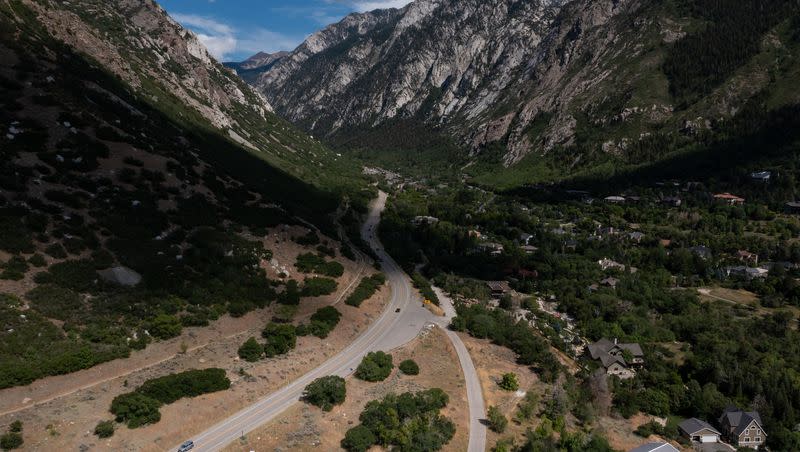Private funds should help pay for Little Cottonwood gondola, Utah governor says

- Oops!Something went wrong.Please try again later.
Utah Gov. Spencer Cox says the state shouldn’t be the only one paying for a gondola up Little Cottonwood Canyon, which some estimates suggest could cost over $1 billion.
Instead, private stakeholders should help pay for the project, he told reporters Thursday during the monthly PBS Utah news conference.
“I don’t think the state should do it alone,” Cox said. “And so those conversations will be ongoing — How much private participation can we get in building the gondola and of course, implementing the record of decision that has come forth from UDOT.”
According to the Utah Department of Public Transportation, or UDOT, the project will cost $729 million, and will span roughly 8 miles, taking skiers and snowboarders from the bottom of the canyon to Alta and Snowbird ski resorts.
But in a plan recently passed by the Wasatch Front Regional Council, the gondola has a phased cost of just over $1 billion — other independent analyses estimate the project will go above that. Politicians, like Salt Lake County Mayor Jenny Wilson, and other anti-gondola activists are quick to point out inflation and unforeseen expenses could push the gondola well over budget, using the newly constructed state prison as an example, which was initially slated to cost $650 million but ballooned into a billion-plus dollar project.
Related
The gondola was officially recommended by UDOT on July 12. But actual construction on the massive project — which would bring 22 towers roughly 200 feet high to Little Cottonwood Canyon — is years away.
Per UDOT, the state aims to take a phased approach which first entails spending $150 million allocated by lawmakers this year to increase busing up the canyon, implement parking restrictions and build tolling infrastructure.
On Thursday, Cox said the state will be “monitoring” the first phase to decide what to do as the process moves forward.
“We’ll look at the price tag and make a determination of how much of that will be funded on the public side. And then if there are private partners out there, how much they’re willing to put towards this project,” he said.
The governor didn’t specify what private entities should be involved in the funding process. There are several stakeholders who have been vocal in their support for the project, forming a coalition called Gondola Works that includes Snowbird, Alta, Ski Utah, UCAIR, Utah Clean Cities, Love Communications, Exoro Group and POWDR, Snowbird’s parent company. It also includes CW Management, a development company started by former Utah Senate President and current State Homeless Coordinator Wayne Niederhauser and former Sandy City Councilman Chris McCandless.
Related
The second phase includes widening Wasatch Boulevard, building new snow sheds — a structure with a sloped roof designed to protect the roadway from avalanches — and trailhead “parking improvements.”
And the third phase is the actual construction of the gondola and a parking garage at the bottom of the canyon with 2,500 parking spaces. Both the second and the third phases are dependent on funding.
There’s still no guarantee the gondola will even be built. UDOT’s project manager Josh Van Jura told the Deseret News it’s possible that the first two phases could be so successful that it will negate the need for a gondola.
“Because something has been cleared environmentally does not mean that it’s a foregone conclusion that it’s going to be built,” he said in July.
Related
Would a gondola have helped during this winter’s avalanche control, interlodge closures?
Utah has experienced record levels of snow this season — here are the numbers
This winter brought historic snowfall to Utah, and kept Little Cottonwood Canyon closed for days at a time. There were 27 operations when artillery was used for avalanche mitigation in the canyon, during which the gondola would not have been operational. But even on clear days, skier traffic headed to Alta or Snowbird resorts can result in gridlock that traps people in their homes in Sandy, and turns a 15-minute drive into an hourslong wait.
“Certainly public transportation is within the purview of state government. And this is a public issue for those that live in those neighborhoods and for Utahns all across the state who are trying to get up those canyons and recreate,” Cox said Thursday.
Correction: An earlier version misstated the cost estimate put forth by the Wasatch Front Regional Council, which suggested the gondola project would cost nearly $1.3 billion. The actual estimate is just over $1 billion.

